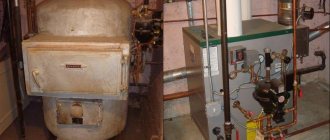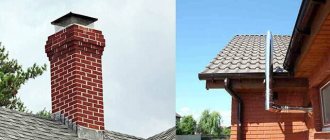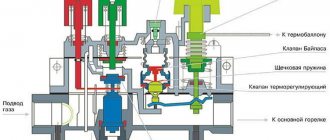When arranging the gas supply for your home or apartment, you need to think through a huge number of things, in particular, the distance from the outlet to the gas pipe, regardless of when the electrical wiring was installed or reconstructed, before or after the development of the project.
The next crazy requirements, recommendations to complicate the process, or reasonable standards? What happens if you don’t follow the rules and put wires anywhere?
We will answer these and many other questions about the combination of electricity and gas supply in one room in detail.
Standards for private houses
According to the regulations, gas heating equipment can only be placed in rooms with good ventilation, which are located:
- On the first floor of the building;
- At the plinth level or in the basement;
- In the attic;
- In the kitchen (only boilers with a power of no more than 35 kW are suitable for installation in kitchens).
In the latter case, it is necessary to take into account not one standard, but two at once. The first of them allows you to install units with a power of up to 35 kW, and the second - up to 60 kW. These standards refer only to heating equipment - no requirements are imposed on any other devices using gas.
To know exactly what standard needs to be followed in a particular situation, you need to contact your local gas service - it is their employees who will put the equipment into operation after installation. Information about current standards can also be obtained from the designer - in the end, the source of information is not particularly important, only the result is important.
The result in this case is an understanding of the rules for installing gas boilers. In addition, you need to have an idea of what kind of room is needed for a gas boiler so that it can be installed and put into operation, having gone through the stage of coordination with the relevant services.
The placement of a gas boiler in a private house, depending on its total power, should be carried out as follows:
- Power up to 150 kW - installation is possible on any floor where there is a free separate room;
- Power from 150 to 350 kW - equipment can be installed in a separate room no higher than the first floor, as well as in extensions.
If the equipment power exceeds 350 kW, then it is prohibited to use it in private homes.
Easily removable window structures
An easily removable building envelope (ELS) is window glass that easily breaks under excessive pressure in the event of an emergency. The window opening is completely freed, while all the supporting structures of the building maintain their integrity.
Easily removable window designs
The use of reinforced glass for glazing LSC is prohibited, since it is too strong and does not collapse under the influence of loads. The same goes for polycarbonate, triplex and stalinite.
According to GOST standards, special elements can be used instead of simple glass in light-removable structures.
It could be:
- a rotating flap, which, in the event of a gas explosion, even with a slight excess of pressure, swings outward or rotates around the fastening elements;
- a displaceable element that includes a window frame with a double-glazed window - in the event of an emergency, the structure falls apart and flies out onto the street.
To equip window units with a combustion chamber operating on gas, safety locking mechanisms, latches and self-destructive fasteners are used. Their function is to ensure the smooth release of the displacing or rotating device under the influence of excessive pressure.
Thus, it is not only the size of the window unit that matters. With its help, an opening is cleared for the release of the energy generated during the explosion of the combustion equipment.
Standards for installing a gas boiler in the kitchen
If the kitchen is selected as a site for installing gas heating or water heating equipment with a power of no more than 60 kW, the room must meet several requirements:
- The total volume of the room for installing a gas boiler must exceed 15 m3, and another cubic meter is added for each kilowatt of boiler power;
- The height of the room must exceed 2.5 m;
- The ventilation system must provide exhaust volume three times the size of the room;
- The air flow through the ventilation system should also be three times the volume of the room, and this value does not include part of the air spent on the combustion process;
- The room under the gas boiler must have a window with a window (the area of the window is selected depending on the thickness of the glass);
- The room door should not be located close to the floor, but at such a distance that the total gap area exceeds 0.025 m2.
There is an additional rule that is not noted in the standards, but requires fulfillment - gas heating equipment can only be installed in those rooms that have a door. Failure to comply with this rule (as well as all others) always leads to refusal to put the boiler into operation.
Today, meeting the requirement for a door in a room with a gas boiler can be problematic. In modern construction there is a tendency to remove most partitions and form arches in doorways. The solution to the problem may be non-standard door options. Glass doors are also a good option, as they do not overload the interior, but still perform their function.
How to avoid problems?
First of all, following the rules is your health and safety for your life.
Therefore, if you combine gas and electric, use a few simple recommendations:
- Follow the rules of the PUE and SP exactly.
- At the entrance to your apartment, install a protective shutdown device that guarantees a power outage in case of problems with the neutral wire.
- Before installing the wiring, make sure that the new one will match the wiring of the old circuit (if it does not change).
- A gas stove cannot be grounded through a gas pipeline, just like ordinary household items that run on electricity.
And in addition, be sure to use the services of experienced electricians and enter into contracts when installing electrics for gas appliances.
Always check the license and documents of the gas workers whom you call to install gas-using equipment. In addition, be sure to conclude a bilateral agreement and check that the electrical installation of the devices is carried out in accordance with all the rules
All these recommendations will help you avoid problems with regulatory authorities and ensure a safe energy supply.
Requirements for individual premises
Boiler rooms located in separate rooms must meet a number of requirements, which are very similar to the previous ones:
- The ceiling must be at a height of over 2.5 m;
- The area and volume of the room are selected depending on individual preferences, but the minimum allowable volume is 15 m3;
- Each boiler room wall must have a fire resistance limit of 0.75 hours and no flame spread (brick, concrete and building blocks meet this requirement);
- Ventilation is subject to the same requirements as when installing a boiler in the kitchen - three times the outflow and the same amount of air intake, increased by the volume of oxygen consumed during the combustion process;
- The room must have at least one window with a glazing area of 0.03 m2 per 1 m3 of room volume.
When installing gas boilers with a power of over 150 kW, it must be possible to exit the boiler room directly onto the street. Placing a gas boiler in an individual residential building assumes that the equipment cannot be adjacent to living rooms. In any case, the boiler room must be equipped exclusively with fire doors.
An important point is that the room standards for installing a gas boiler take into account the glazing area, and not the size of the window itself. In some situations, it is regulated that the room must have at least one glass with an area of more than 0.8 m2. If necessary, such a window can even be placed in the door - there are no rules about its location in the regulations, and in this case there is no need to track the distance from the boiler to the window.
Glazing material
When installing a window for a gasified boiler room, special requirements are also imposed on the frame material. They must be resistant to high temperatures and made from environmentally friendly materials.
Aluminum or metal-plastic is used to construct the window structure. The aluminum profile protects the heated compartment from adverse climatic conditions. It provides reliable sealing that prevents the formation of drafts and prevents the fire in the boiler from going out even with strong gusts of wind outside.
Metal-plastic frames are no less reliable and help retain heat in the furnace room.
Plain sheet glass is used as a glazing material. It is also allowed to install double-glazed windows that meet the requirements of GOST and act as easily removable structures.
Extension of boiler rooms
Of course, it is very convenient to have a separate room for gas equipment, but this is not always possible, and you have to think about where to place a gas boiler in a private house under such conditions. The solution to the problem is to add a boiler room.
The standards in this case coincide with those described above, but there are a number of additional requirements:
- The boiler room can only be attached to a solid wall;
- The distance between the nearest window or door should be more than one meter;
- The boiler room can only be laid out using non-combustible materials that can last at least 0.75 hours before ignition;
- The walls of the boiler room itself must be erected separately from the main building - i.e. you will need your own foundation and four new walls.
In order for a gas line to be installed into an equipped boiler room, the building must be registered. In the absence of appropriate documents, representatives of the gas service will simply refuse to approve the equipment, even if all standards are met.
If the main building has not yet been built, then during the design process you need to find out what the room for the gas boiler should be like and comply with all the requirements, otherwise putting the boiler into operation will be impossible. When installing a boiler in an already constructed building, you can allow small deviations in some parameters, but they must be compensated for by others.
Network load calculation
When deciding how to install an outlet for an air conditioner, you should take into account the power consumption of the electrical device. This is necessary to ensure reliable power supply to the cooling system and eliminate the possibility of an emergency. This information is contained in the technical data sheet of the device. To cool a larger area of the room, choose a more powerful air conditioner. The maximum load on the network when operating household air conditioning systems does not exceed 10A. Therefore, when installing them, you can use a standard plug socket with a rated load of 16A.
High power cooling devices are used for large areas. Their installation is carried out using special equipment for direct connection. The connection point, regardless of power, must have a grounding device. If other household appliances are connected to the line, the total power is taken into account in the calculations.
The distance from the gas pipeline to the electric cable is a distance determined by the need to comply with the security zone of both types of structures, their location and broadcast intensity.
Installation of a gas boiler in combined kitchens
In modern construction, the arrangement of studio apartments or layouts in which the living room and kitchen are combined into one large space is actively practiced. Of course, such a solution has a lot of advantages - for example, it opens up a large portion of free space, which is perfect for implementing all kinds of design ideas.
The problem is that gas services regard such layouts as residential, so the installation of any gas equipment in them is prohibited. In studios this problem cannot be solved, but when combining a living room with a kitchen, options are possible.
So, it is quite possible to call the room “kitchen-dining room” during the paperwork process. Thanks to this name, the combined room will not be considered residential, so you can safely install a gas boiler in it. Another option is the installation of a sliding partition between the rooms or a complete re-issuance of all certification papers.
Why keep distance
The kitchen is the busiest area with electrical appliances. A refrigerator, a microwave oven, an exhaust system, a dishwasher - these are a small fraction of household appliances, without which it is impossible to imagine it. Therefore, safety in this part of the apartment should come first. Electricity, gas and water supply are useful inventions, but in the hands of a hack or an irresponsible person they become the cause of fires, injuries, and accidents. To avoid such troubles when developing a kitchen design, you need to carefully consider all the details of the interior, and also carefully consider the location of sockets in relation to the gas pipe, hob, and heating appliances. Health, well-being, and sometimes even human life depend on it.
Gas boiler location
A gas boiler in an apartment is usually placed in the kitchen, which is determined by the presence of all the necessary communications, and the distance from the gas pipe to the boiler is maintained without problems. As a rule, wall-mounted boilers are used for apartments, which are attached to the walls using special brackets that come with the equipment.
If the house has a staircase leading to the top floor, the owners have a desire to install a boiler under it. As a rule, the volume of space under the stairs is enough for a boiler, but there are problems with ventilation, so it has to be arranged separately using large-diameter pipes.
Deciding where to install a boiler in a private home depends on the format of the equipment and the requirements specified in the attached documentation. The passport for the boiler always indicates the required distances from the walls, ceiling and opposite wall, and you should definitely focus on these indicators.
It's time to replace the gas meter
When is it time to change the meter?
Each meter has a verification period. Usually this time is from 8 to 10 years. The first verification takes place at the time of installation of the meter. Thus, the verification time falls exactly in the middle of the device’s service life.
If the meter is in good working order and measures the readings correctly, then it is left in operation for another period. And if the readings are not accurate, then the gas meter must be replaced.
You were told to install a meter of a certain brand, what should you do?
No one can oblige you to install a specific brand of gas meter. The service organization is obliged to accept from you any metering device certified in the Russian Federation. The main thing is that the technical requirements are met.
What technical requirements must be taken into account when choosing a gas meter?
- Counter volume. Usually this parameter appears directly in the name of the counter after the letter “G”. For example G4, G6, G10. The larger the volume, the greater the throughput.
- Thermal correction. The meter can be installed both in a heated room and outdoors. Outdoor temperatures can vary by 80-90 degrees throughout the year. Therefore, it is necessary to install a thermal corrector in street meters to correctly account for consumed gas. This parameter also usually appears in the name of the meter and is designated by the letter “T”. G4 - without thermal corrector, G4T - with thermal corrector.
- Distance between centers of gas supply pipes. This parameter can be measured using a ruler. Standard distances between pipe centers for household gas meters: G4 – 110 mm G6 – 200 or 250 mm G10 – 250 or 250 mm
- Gas inlet direction. Stand facing the meter display. If the gas inlet pipe is on your left, it means the gas supply is from left to right. If on the right hand, then from right to left.
- Thread diameter. The pipes through which gas flows must be hermetically sealed in the meter. And if the diameter of the pipe is, say, 40 mm, and the thread on the meter is 32 mm, then of course they will not meet at the junction. But unlike the problem of non-standard distance between pipes, the problem with threads is quite simply solved with an adapter nozzle.
Which brand of counter should I choose?
There is no clear answer here. Call us at 8-962-957-32-80, we will advise you and help you with your choice.
Installation features according to SNIP
In the absence of specific recommendations in the documents attached to the boiler, it is worth using SNIP standards, according to which:
- Installation of gas boilers is only possible on walls made of non-combustible materials. The distance from the gas boiler to the wall must exceed 2 cm.
- If the walls are still subject to combustion, they must be protected with fireproof material. The most common options are a layer of asbestos with a metal sheet, plaster over 3 cm thick, ceramic tiles or mineral wool cardboard.
- On the sides, the distance from the boiler to the wall must be at least 10 cm. If the walls are made of flammable materials, this distance increases to 25 cm.
- A gas boiler can only be installed on a substrate made of non-combustible material. In the case of wooden coverings, special supports are made from tiles or bricks, which provide the necessary fire resistance. The base for floor-standing devices must be at least 10 cm wider than the dimensions of the boiler itself.
Scheme of arrangement of power supply and ventilation
According to regulations and technical conditions, the gas boiler must also be connected to the electrical network. Run a cable with a cross section of 1.5x3 mm from the meter. Don't forget to install a circuit breaker that will protect against power surges.
Be sure to ground the equipment. The minimum distance from the nearest outlet to the gas appliance should not be less than 10-12 cm.
To ensure maximum productivity of a gas boiler, good ventilation must be provided. To do this, install a special grille, which should be placed at a distance of 25-30 cm from the ceiling. The minimum size of the hole should be 10x10 cm. Fresh air may be taken from non-residential premises, the street or the corridor.
Important! Calculate the ventilation area based on government regulations. For 10 kW of boiler power, 0.001 m2 will be required.
If you connect a heating device to a coaxial chimney, it can be discharged through an external wall. In this case, fresh air enters through the pipe from the street, and smoke and combustion products are freely removed outside.
What to do if the device breaks down
Any mechanical device can fail over time. Gas meters also do not escape this fate.
Breakdowns may vary depending on the type of meter:
- If we talk about electronic means of metering gas consumption, digital values are not reflected on the screen, or they are viewed, but only in fragments;
- for other types - the meter may freeze in place (this is noticeable visually), or there is a slight gas leak in the places where the meter is attached.
If, however, any problems are observed in the operation of the device, they can be eliminated in several ways. Regardless of when the specialist discovered a violation of the sealing of the accounting device, when he is called by the owner of the apartment or during the next medical examination, a report is drawn up.
In it, a representative of the organization indicates the identified fact of violation. When this happens, the owner of the equipment will be required by law to pay the company for the resource consumed, but according to the standards, this is an order of magnitude higher than payment according to indications.
Payment is calculated for the last six months of using the resource. By analogy with this technique, resource consumption is calculated when there is no metering device.
Please note! If the seal remains intact, but the gas engineer, during a routine inspection, discovers that the meter is faulty, you will also have to pay for gas according to the standard for the last 6 months.
It is believed that if the consumer did not report an obvious breakdown, he deliberately concealed the fact of incorrect recording of resource consumption.
A message about recalculation of the amount due to a violation will be sent to the consumer within 30 days. The company is obliged to notify about the recalculation and calculate the amount due.
If a malfunction of the device is discovered by the homeowner, and this is reported to the service company, a specialist arrives on site, determines that the seal is in place, and records the fact of the malfunction.
Here, calculation of consumption, based on approved standards, will be made only from the moment a malfunction is identified until the installation of another serviceable device.
Cost of specialist work
Prices for assembly, installation and connection of the grounding loop depend on the specialist or company, region, and type of soil on the site. In Moscow and the Moscow region, the cost of work is about 4,500-6,000 rubles, in St. Petersburg - 3,900-5,500 rubles, in the regions - on average from 3,000 to 4,000 rubles. Please note that the price does not include the price of the grounding kit (another 6-10 thousand).
Most companies carry out turnkey installation and indicate prices taking into account the cost of the finished grounding kit.
Gas boilersInstructionsBoilers
Calculation of parameters to achieve the required resistance
To determine the resistance, it is necessary to assemble the components into a single circuit and take measurements. If the parameter is within 4–8 ohms, then you can begin installing the structure in the soil. Otherwise, the resistance must be brought up to normal by adding or removing conductors or changing the cross-section of the rods used. It is possible to calculate the parameter by a specialized company. When determining, the air temperature and soil type are taken into account, which increases the accuracy of determining the resistance.











